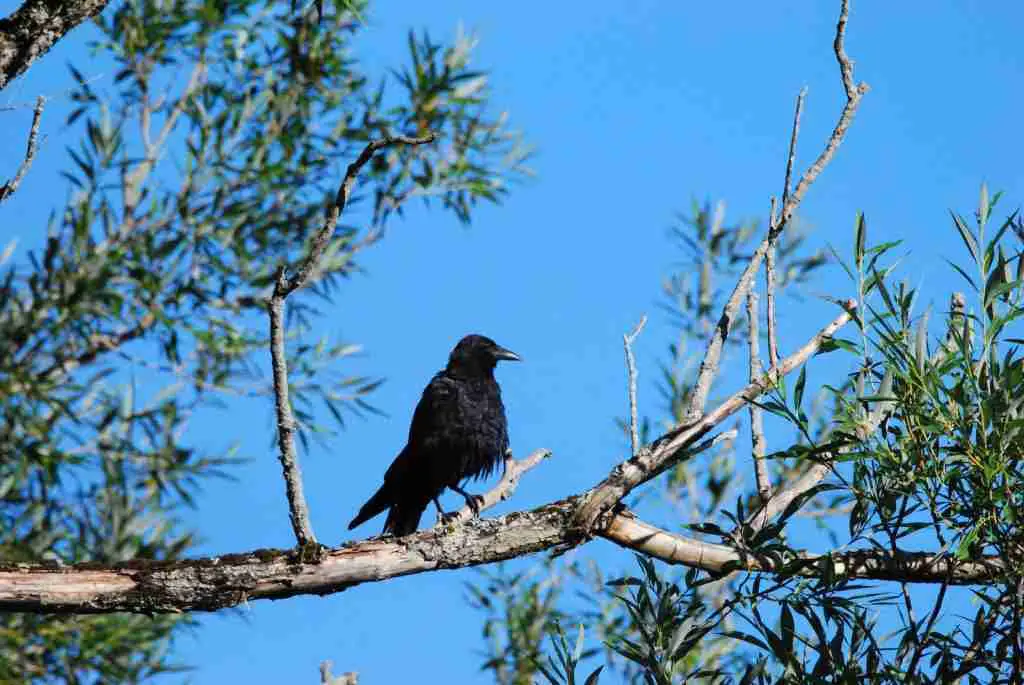As an ornithologist, I’m often asked how high can a crow fly? It’s an interesting question that has been examined many times over the centuries. The answer varies depending on several factors including weather conditions and the type of crow in question. In this article, I’ll explore different aspects of crows’ flight patterns and explain what determines their maximum altitude.
Crows are highly adaptable birds with wingspans ranging from 30-50 inches wide, allowing them to soar through the sky like no other creature in nature. They possess powerful muscles, giving them the ability to reach remarkable heights when they take off into flight. But just how far can these majestic creatures go? Can they break records or even reach outer space?
The answers may surprise you! Crows have proven themselves capable of flying at dizzying altitudes if the right conditions exist; however, there is still much debate surrounding how high crows can actually travel without being hindered by environmental elements such as air pressure or wind currents. To determine precisely how high a crow can fly requires further research into these areas and more.

Flight Capabilities Of Crows
It is often said that ‘where there’s a will, there’s a way’ and crows are one of the most capable creatures when it comes to flight. As an ornithologist, I have observed crows taking off in almost every type of environment with ease. On average, crows can reach heights of up to 1000ft (304m). This gives them access to many areas where other birds cannot go and provides them with much needed security from predators. However, their ability to fly higher than this depends on various factors which we will now discuss. From here we transition into considering the factors affecting a crow’s altitude…
Factors Affecting A Crow’s Altitude
The altitude of a crow’s flight is determined by various factors. An ornithologist studies these to better understand the behavior and habitat of crows. Factors influencing the maximum height that a crow can reach include:
- Body Size
- Wing Span
- Wind Conditions
- Air Pressure
These all interact with each other, causing an individual crow’s ability to fly higher or lower in certain conditions. For example, larger birds tend to have greater wing span which allows them to take advantage of air currents more efficiently than smaller species, resulting in higher altitudes being attainable during flights. Additionally, strong winds will give a boost to any bird, allowing it to climb above its usual heights; conversely weaker winds may limit the potential for reaching high altitudes as well as remain airborne for prolonged periods of time without expending too much energy on flapping their wings. Lastly, changes in air pressure affect how easily a bird can glide through the sky and thus may also determine the ultimate peak reached by a crow during its journey into the heavens. Thus overall there are numerous factors at play when determining just how far up into the skies crows can soar from one moment to another! With this understanding, we turn our attention now towards examining some of the migration patterns observed in crows throughout different seasons of their life cycle.
Migration Patterns Of Crows
Crows soar through the sky like a symphony, flocking with their friends and families in search of new horizons. Although crows may not travel to great heights as quickly as some other birds, they do possess an impressive flying ability that enables them to migrate annually from one area to another.
Usually, migrating crows will fly at altitudes between 2,000 and 10,000 feet above ground level when conditions are suitable for flight. In inclement weather or during night time hours, these birds have adapted to fly lower than usual so that they can avoid dangerous winds or difficult terrain. This often means descending below 1,000 feet above ground level though this is by no means a consistent pattern among all species.
The journey undertaken by a crow usually follows predetermined routes known as “flyways” which connect areas where the bird breeds in summer months with winter habitats further southward. These paths typically run along coastlines and mountain ranges since these features provide helpful landmarks for navigation purposes but also offer shelter from strong wind currents. During migration periods, individual crows may congregate into larger groups called murmurations before continuing on their respective journeys together.
Types Of Flying Techniques Used By Crows
Crows are highly adaptable flyers and employ a variety of flying techniques. They use flapping flight, which is the most energy-intensive type of flight, to get off the ground and reach heights up to 3,000 feet or more. In addition, they can soar on thermals or updrafts over long distances at high altitudes to conserve energy when traveling from one location to another. Gliding is also an important form of locomotion for crows as it allows them to travel between trees in forests with minimal effort. Finally, crows can perform acrobatic maneuvers such as diving, rolling, looping, turning abruptly and quickly changing directions. All these strategies enable them to fly higher than other birds of similar size and weight.
As such, environmental factors play an important role in determining how high crows can fly. Temperature gradients within air masses allow crows to gain lift by riding thermal currents upward. Additionally, wind speed affects their maximum altitude; stronger winds mean that crows have greater potential height due to increased uplift force generated by the gusts. Understanding these dynamics helps us comprehend why some crow populations live at much lower elevations compared with others living across different regions.
Environmental Impact On A Crow’s Flight
The transition between the types of flying techniques used by crows and their environmental impacts is a seamless one, like wings gliding through the sky. The environment has an uncanny ability to affect how high a crow can soar into the heavens. With variables such as altitude, wind speed, air temperature and humidity all playing roles in determining how far or high a bird can fly, it’s important to understand how each affects them.
Altitude plays an essential role in aerodynamics; at higher altitudes dense air provides greater lift while thin air offers less resistance. As elevation increases, so too does the amount of energy required for a crow to stay airborne. Similarly, strong winds act as tailwinds helping birds propel forward with greater ease than headwinds that force birds to exert more effort to maintain their flight path. Temperature also influences flight efficiency, hot temperatures require additional energy expenditure due to increased turbulence while cooler temperatures reduce drag which makes it easier for birds to remain aloft. Lastly, relative humidity levels have been shown to decrease wingbeat frequency when higher compared to lower humidities decreasing fatigue during longer flights making it possible for crows travel further distances.
By understanding these different factors affecting avian aerial performance we are able better appreciate not only how high crows can fly but also why they might choose certain routes or patterns of migration over others depending on given climatic conditions.
Frequently Asked Questions
How Long Do Crows Live?
Crows are fascinating creatures that boast impressive lifespans. Crows, with their glossy black feathers and mischievous cawing, can live for up to 15 years in the wild, making them one of the longest-living birds in North America. This is remarkable considering they inhabit a wide variety of habitats all over the world.
Wild crows face many different threats throughout their lifetime including predators, diseases, extreme weather conditions and competition for resources. Despite these harsh realities, crows have been known to survive more than two decades in captivity when provided with proper care and nutrition. In addition to their long life expectancy, crows also possess superior intelligence as well as problem solving abilities which may help contribute to their longevity.
The ability of a crow to survive so far beyond what is expected of most species makes it truly unique among its peers – an impressive feat indeed! It’s no wonder then why humans admire and respect this resilient bird so much; although we often take our own lives for granted, the lifespan of a crow serves as reminder about how precious life really is.
Are Crows Social Animals?
Crows are intelligent, social birds that reside in many different parts of the world. As such, it’s not surprising to find out that they live together and interact with one another on a daily basis. Ornithologists have long studied their behavior and concluded that crows indeed form strong bonds within their flocks. In some cases, these groups may even be considered family units due to how closely they’re connected.
When observed in the wild, crows often travel in large numbers as a means of protection against predators. They also communicate through vocalizations and physical cues, which helps them coordinate when hunting for food or facing danger. Furthermore, research has shown that crows are capable of recognizing individual humans who threaten them; this is why you’ll sometimes see them scolding people who come too close to their nests!
Crow society is complex and fascinating—and understanding its intricacies can help us better appreciate these clever birds. It’s clear that crows are highly interactive animals whose relationships are deep-rooted and meaningful. These qualities make them truly special creatures worth observing and appreciating.
What Is The Average Size Of A Crow?
Crows are a widely distributed species of bird, with over 40 different types known to exist. As such, they come in many shapes and sizes, with the average size being largely dependent on the specific geographical location of each individual crow.
In general terms, crows measure between 17-21 inches (43-53 cm) in length from beak to tail. Their wingspan can range anywhere between 26-41 inches (66-104 cm), depending on their particular subspecies. The weight of an adult crow is also highly variable, ranging from 12-57 ounces (340-1,610 g). In comparison to other avian species of similar size and shape, crows tend to have relatively large beaks and heads as well as long legs that allow them to easily traverse difficult terrain or access food sources located higher up trees.
To better understand this common avian species here are five key characteristics:
- Crows typically measure around 17–21 inches (43–53 cm) in length from bill to tail.
- They have a wingspan that ranges from 26–41 inches (66–104 cm).
- Weight varies greatly among crows but usually falls within 12–57 ounces (340–1,610 g).
- Crows’ bills and heads are larger than most birds’ of similar size and shape.
- Long legs enable them to move quickly through rough terrain or reach high branches for food sources.
From its physical features alone it is clear why the crow has become so widespread across much of the globe—it is an extremely adaptable creature that readily thrives near human settlements while still able to survive in more wild habitats too. Moreover, its ability to mimic sounds make it one of the most intelligent members of the avian family; a fact which endears it even further into our collective hearts!
How Do Crows Communicate With One Another?
How do crows communicate with one another? This is a fascinating question and one that ornithologists have studied for many years. Have you ever noticed how crows seem to be able to understand each other, especially when they are in large flocks? How is this possible?
Crows use various vocalizations and body language to signal danger or alert others of potential food sources. Cawing, clucking, rattling, and rasping are all examples of the different calls used by crows; these can convey a range of meanings depending on context. For instance, loud, harsh cries may indicate alarm while softer murmurs might suggest contentment. In addition to their vocalizations, crows also make use of physical displays such as raising feathers to signify aggression or bowing down towards an individual crow which is seen as appeasement behavior.
But it’s not just verbal and non-verbal cues that allow crows to effectively communicate with one another – there’s also evidence that some species possess cognitive abilities far greater than previously thought. Research has shown that certain types of crows can even recognize human faces! What other secrets about crow communication remain undiscovered?
What Is The Typical Diet Of A Crow?
In studying the common crow, it’s important to understand the typical diet of these birds. Crows have a varied diet and are omnivorous scavengers that feed on grains, fruits, insects, small animals and carrion. As opportunistic feeders, they can often be found in fields going through crop residue looking for seeds or insects to eat. They will also visit birdfeeders as well as garbage cans in search of food.
Crows use their strong bills to dig up earthworms from the ground and look for grubs under bark or stones. In addition to this, crows may hunt mice, frogs and nestling songbirds along with other small animals. During winter months when food is scarce, crows rely heavily on acorns and nuts as an energy source. To supplement this diet, some crows even fly long distances over open water in order to reach areas abundant with mussels and clams which they then eat whole before returning home.
Overall, we see that crows have flexible diets allowing them to survive almost anywhere by taking advantage of whatever resources are locally available. This versatility helps explain why these birds have been so successful at adapting across many different habitats around the world today.
Does the Speed of a Crow’s Flight Change Depending on its Altitude?
The speed at which crows fly varies depending on their altitude. Research shows that how crows fly speed is affected by factors such as air density, wind patterns, and the need to conserve energy during flight. Higher altitudes may allow crows to maintain faster speeds due to reduced air resistance, while lower altitudes can limit their velocity.
Conclusion
It is clear from the research that crows are an incredibly adaptable species, with a wide variety of behaviors and adaptations. To conclude, crows have an impressive wingspan which enables them to fly up to 3,000 feet high! That’s nearly three times as high as the world’s tallest building – the Burj Khalifa in Dubai. This remarkable feat speaks volumes about the capabilities of this amazing creature.
Crows are also highly social animals, using their calls and other forms of communication to stay connected over long distances. They form strong family bonds, often living together in large flocks for protection and companionship. And while they’ve been known to scavenge human food sources when necessary, their typical diet consists mostly of insects and small mammals like mice or voles.
As ornithologists, we can appreciate just how incredible these birds truly are – whether it’s soaring through skies thousands of feet above ground level or navigating complex networks within their own communities. It is my sincere hope that by exploring these fascinating aspects of crow behavior, more people will come to appreciate these magnificent creatures for all they do!

An avid ornithologist, zoologist and biologist with an unwavering passion for birds and wild animals.
Dr. Wilson’s journey in ornithology began in childhood and led him to obtain a Ph.D. in Ornithology from the prestigious Avian Research Institute. He has worked closely with renowned experts in the field and conducted extensive research and field studies globally.




